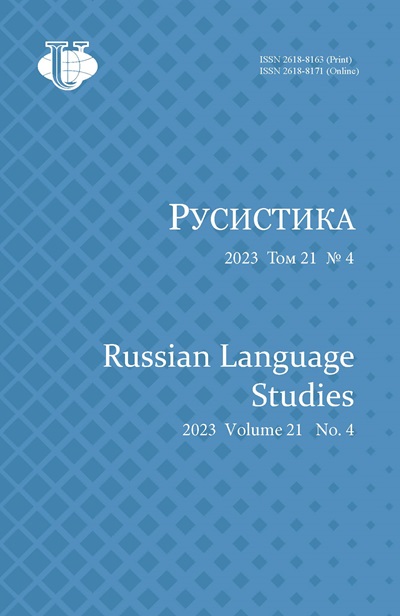DISCURSIVE ANAPHORA PRAGMATIC MODELS IN MONOLOGIC TEXT
- Authors: Sknar G.D.1, Kudryashov I.A.2
-
Affiliations:
- Rostov State Medical University
- Southern Federal University
- Issue: Vol 15, No 1 (2017)
- Pages: 51-65
- Section: Articles
- URL: https://journals.rudn.ru/russian-language-studies/article/view/16029
- DOI: https://doi.org/10.22363/2313-2264-2017-15-1-51-65
Cite item
Full Text
Abstract
The aim of the article is to determine the pragmatic particularities of the monologist text thematic organization based on the discursive anaphora models. This aim predetermines the tasks connected with 1) outlining the conception of the theme as a textual segment manifesting sustained dependence on the fictional monologist text discursive scheme; 2) considering the fictional text monologist sphere based on the role the thematic components play in it; 3) revealing the referentially dependent anaphoric linguistic expression sequences which form the thematic components within the frameworks of the monologist text discursive scheme with regard to the communicative specifics of the text. The conclusions made in the article allow to get closer to a fuller understanding of how the cohesion relations and the anaphoric relations modeled by the thematic components facilitate the reader’s task on integrating the utterance discursive characteristics into a more global interpretative structure. It is proved that both phenomena forming the symbiosis realize the function of sustaining the meaning continuality and the referential plane of the connected utterances in the monologist text. This statement outlines the scientific significance of the research conducted. The practical significance of the article is determined by the possibility of using its basic results for further development of the problem of the «informational packing» for the utterances belonging to the monologist conversational genres, for revealing the mechanisms of the fictional text organization as the whole. The theoretic deductions achieved in the article could be used in teaching the contemporary Russian language in higher educational establishments, stylistics of decoding, special courses in philological hermeneutics and the courses devoted to the discursive basics of the monologist text organization.
About the authors
Galina Dmitrievna Sknar
Rostov State Medical University
Author for correspondence.
Email: vitsknar@aaanet.ru
doctor of philological science, head of the Russian language and Russian speech culture department
Nahichevansky Lane, 29, Rostov-on-Don, Russia, 344022Igor Alexandrovich Kudryashov
Southern Federal University
Email: igalk@mail.ru
doctor of philological science, professor of the language theory and the Russian language department
Bolshaya Sadovaya str., 105/42, Rostov-on-Don, Russia, 344006References
- Glagolev N.V. Vychlenenie semanticheskih jelementov kommunikativnoj strategii v tekste [Extracting semantic elements of the communicative strategy in the text]. Filologicheskie nauki. 1985. № 2. P. 55—62. (In Russ.)
- Dolinin K.A. Implicitnoe soderzhanie vyskazyvanija [The utterance implicit content]. Voprosy jazykoznanija. 1983. № 6. P. 37—43. (In Russ.)
- Cavins J. Text World Theory. An Introduction. Edinburgh: Edinburgh University Press, 2007. 193 p.
- Goncharova E.A. Antropocentrizm hronotopa kak konceptual’naja osnova hudozhestvennogo teksta [Hronothrope anthropocentrism as the fiction text conceptual basis]. Kategorizacija mira: prostranstvo i vremja: Materialy nauch. konf. M.: Dialog — MGU, 1997. P. 40—43. (In Russ.)
- Pushmina S.A. Tekstovoe mnogomirie i vhod v nego cherez vorota dejksisa [Textual multiworld and the entry in it through the deixis gate]: dis. … kand. filol. nauk. Tjumen’, 2009. (In Russ.)
- Cornish F. Anaphora, Discourse and Understanding. Evidence from English and French. Oxford: Clarendon Press, 1999. 297 p.
- Fateeva E.D. O nekotoryh problemah izuchenija diskursivnoj anafory: poiskah novyh podhodov [On some problems of discursive anaphora investigation: in the search of new approaches]. Jazyk i kommunikacija: izuchenie i obuchenie. Vyp. 11. Orel: OrGU, 2003. P. 18—27. (In Russ.)
- Petrusheskaja L. S. Sobranie sochinenij v 5 t. [Collective works in 5 vol.] Har’kov: Folio; M.: TKO AST, 1996. T. 1. 256 p. (In Russ.)
- Dik S.C. Anaphora. The Theory of Functional Grammar. Part 2: Complex and Derived Constructions. Berlin, NY.: Mouton de Gruyter, 1997. P. 215—228.















